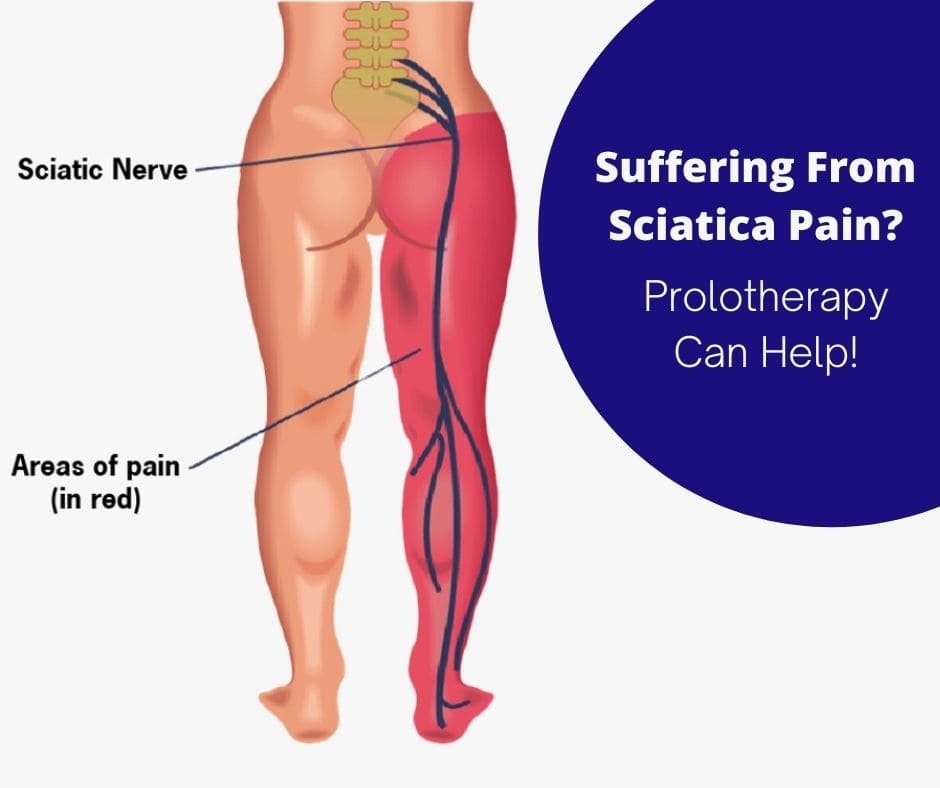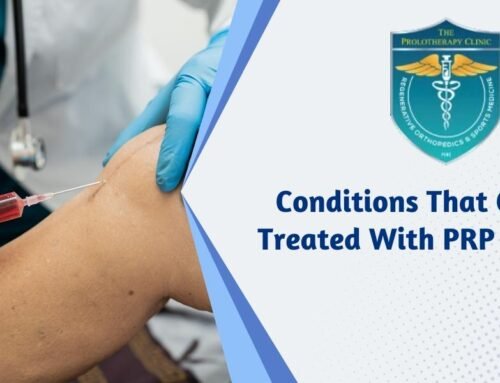Do you experience pain that radiates from the lower part of your back that shoots down to the buttocks, legs, and/or feet and the pain is so bad it will stop you in your tracks?
If so, then this article is for you. Below you will find what is sciatica and specific regenerative treatment options to treat and relieve sciatica pain without surgery.
Sciatica is not a disease or a condition, as you may assume. however, Sciatica is a symptom. The condition is called lumbar radiculopathy. Oftentimes, the terms sciatica and lumbar radiculopathy are used interchangeably. Lumbar refers to the lower back area and radiculopathy is a disease of the root of a nerve.
Usually, the cause of most back pain and sciatica problems is spinal instability. Injury to the ligaments of the back occurred at some point. And typically from lifting heavy weights, jerk injury, bending over, and prolonged sitting/standing, which then stretched the ligaments, and made them vulnerable to injury. The result is weak and lax ligaments. And when ligaments of the lumbar spine are weak, the vertebrae can slide over each other making the disc protrude and pinch the nerve.
What Are the Common Treatments for Sciatica Symptoms of Lumbar Radiculopathy?
-
Chiropractic:
Treat sciatica symptoms with much success. You can also try treatments like massage and stretching for relief. But these therapies will only work on the surrounding muscles, and any relief will very likely be temporary.
-
Regenerative Orthopedics Are One Treatment Option:
If ligaments are weakened, the muscles will be going into spasms. That’s because muscles spasm in an effort to stabilize the area that is currently unstable due to the ligament injury. Muscle-strengthening may be of benefit too. But remember that the underlying injury of the ligaments needs to be addressed. Regenerative Orthopedic treatments, such as Prolotherapy or PRP, are great options for addressing ligament injuries. And they are effective at both repairing and strengthening these types of soft tissue injuries.
-
Pain Killers:
Have you tried painkillers and found no lasting relief? Pain killers(NSAIDs) are frequently used, but they just mask the pain; and that too temporarily. But again, NSAIDs do not repair the injury. They may give you some relief, but they will not fix the underlying problem or heal the injury.
-
Antidepressants and Anticonvulsants:
Are antidepressants and anticonvulsants being recommended? Although you may be depressed because of unending pain, good chance depression is not the source of your back pain. And what about the use of anticonvulsants to treat sciatica? In a 2018 article in the Journal of the American Medical Association (JAMA), the writers note that the commonly used anticonvulsant medication for sciatica called “pregabalin does not improve symptoms of sciatica but frequently has adverse effects.”
-
Epidural Steroid Injection:
If sciatica symptoms do not resolve on their own and the pain continues, a steroid (cortisone) injection may be recommended. Epidural cortisone injections may reduce the size of stressed nerve roots, but they do have side effects. Studies have shown that cortisone causes tissue like the ligaments to grow weaker. So, if weak tissue is the source of the problem, to begin with, then why use something that may make the problem worse? Instead, the spinal instability that is allowing the vertebral segments to move excessively needs to be addressed, so the pain can stop!
-
Surgical Option:
minimally invasive spine surgery may be the surgery you are considering. Surgery may give you relief. However, studies have shown that although there may be a rapid decrease in pain and disability after a few months, years down the road patients still experience mild to moderate pain post-surgery. The patient should consider the risks, complications, and high costs associated with Surgery. And once surgery is done, and if something goes wrong, then it’s can’t be undone.
Until the source of the problem is addressed, you may find yourself exhausted and frustrated at the failure of various therapies to provide long-lasting relief. Not to mention treatments that are ineffective at relieving lumbar radiculopathy and the sciatica symptoms.
Regenerative Non-Surgical Option:
Then it is time to look into a solution that repairs the injury. Regenerative orthopedics can provide an effective option that results in relief and repair while utilizing a non-surgical solution for those with persistent sciatica symptoms and lumbar radiculopathy.
At the Prolotherapy Orthopedic and Physiotherapy Clinic, we treat all of the involved areas of the low back, including the injured ligaments and their attachments to stimulate the body’s own natural healing process. That leads to stabilization of the lumbar spine, which stops the excessive movement and repairs the underlying problem. The result is pain relief. Regenerative Orthopedics is effective at bringing pain relief and return to function for those suffering from sciatica symptoms and lumbar radiculopathy.
Why choose surgery and treatments with side effects? Or those which also lack benefit when there is another option?
Choose the path that repairs the injury and solves the problem. Regenerative orthopedics is non-surgical, plus it is effective.
About Dr.Vikram Rajguru
Dr. Vikram Rajguru is one of India’s first Interventional Regenerative Orthopedic and OrthoBiologic surgeons. He is one of a handful of surgeons in the nation that is both an Orthopedic Surgeon in Pune and an expert in the field of Interventional Regenerative Orthopedics and Sports Medicine.
The Prolotherapy Clinic(PTC®) was founded by Dr.Rajguru as a response to the shortcomings so evident in “traditional medicine,” which largely places a premium on high patient turnover while neglecting long-term health care. PTC® is India’s first center dedicated to practicing regenerative procedures like Prolotherapy in an Orthopedic clinical setting.




